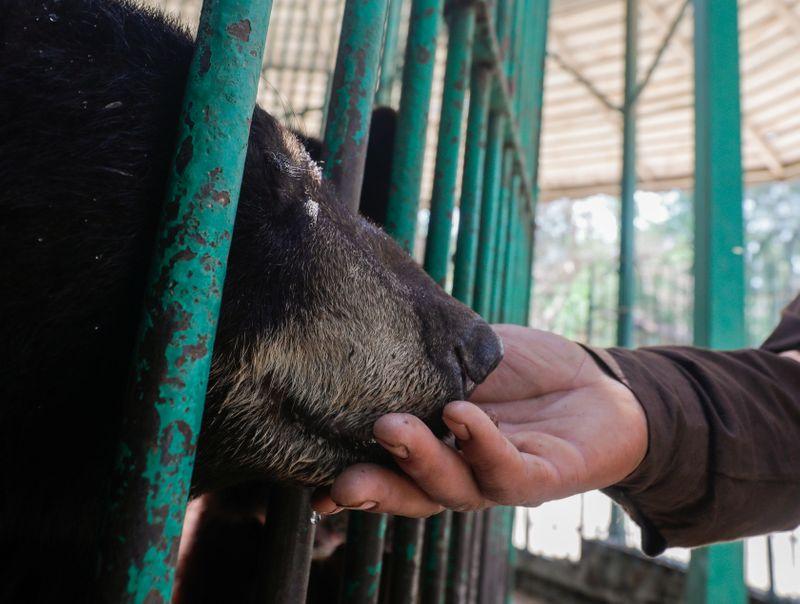
Egyptian zoos are becoming infamous for poor conditions and mismanagement, especially after authorities claimed last year an animal had committed suicide to escape the daily harassment it suffered.
In December 2013, officials blamed suicide for the death of South African baby giraffe “Roca” after reportedly choking to death on a metal shade structure after spending only a year and five months at the Giza Zoo. The then Agriculture Minister Ayman Abu Hadid, along with zoo authorities, claimed the giraffe killed herself because the visitors kept bothering her, though animal rights organizations cited negligence and lack of medical care.
Animal rights activists have heavily criticized Egypt’s zoos as animals often suffer from injuries, untreated diseases and severe starvation, according to animal welfare group “Occupy for Animals.” The group has started a campaign on its website demanding the shutdown of seven government zoos, calling them “hell holes” that shame Egypt.
Dina Zulfikar, one of the country’s most dedicated animal welfare activists and a member of the central zoos supervision committee, says the calls echo her own activism. “I have been calling and lobbying to revitalize the government zoos in Egypt for years,” Zulfikar says. “I wanted the zoo authorities to close down the zoos and turn them into botanical gardens so the animals could be transferred elsewhere and be safe.”
Documenting zoos in Egypt
Al-Masry Al-Youm has visited 10 zoos to report on the conditions of the animals and the facilities, excluding the Arish Zoo because it has been closed down for security reasons, as it is located close to the Battalion 101 Station of the army and the Police Security Directorate.
Ticket prices have been raised several times in the last five years to now reach LE5, no longer rendering zoos a cheap outlet for low-income families.
Visitors say they do not necessarily go to zoos to watch the animals anymore. They are mostly young couples who go to hold hands, kids fleeing from school who annoy the animals most or poor families that merely want to spend time in a garden.
The Giza Zoo, a gem buried in garbage
You can tell that this place was once beautiful. It was opened in 1891 at the time of Khedive Ismail over an area of 80 acres to become the largest zoo in the Middle East. It was called the “Crown Jewel” of all African zoos.
The Giza Zoo has the largest and most diverse number of animals. It is the only park that still includes giraffes and elephants, animals that you would not see in the other zoos.
Neglect and deterioration were the main reason behind Egypt’s membership being dropped from the World Association of Zoos and Aquariums in 2004.
Now visitors can find beggars and vendors walking in the middle of smelly piles of trash.
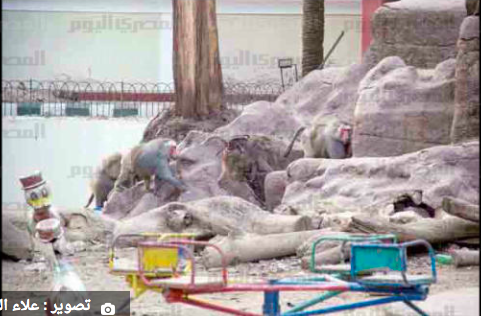
Baboons wander among trash in their enclosure at the Giza Zoo, by Alaa al-Kamhawy.
The Kafr El-Sheikh Zoo, a camel occupies the horse’s cage
The Kafr El-Sheikh Zoo was opened in 1995 inside the Sanaa public park. This means visitors must first buy a ticket for the park for LE1 and another for the zoo for LE5. It is smaller and relatively cleaner than other zoos. But there is no water in the swans’ pond, and there is a camel occupying the horse’s cage as indicated on the sign.
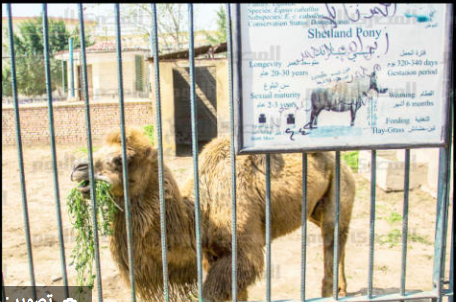
A camel inside a cage at the Kafr al-Sheikh Zoo, by Alaa al-Kamhawy.
The Tanta Zoo, more of a barn
The Tanta Zoo was opened in 1956 over 14 acres, mostly deserted now because many parts of it were closed down. The only official that we met was the man selling the tickets. Because there are no guards, we saw two kids climbing the ring fence around the horses area and harassing the animals.
The types of animals here are not different than the animals you see in barns of rural areas. You may see a goat, a horse, a peacock, some geese and a few monkeys. It is the dirtiest zoo of all, worsened by the workers burning garbage on location, sending poisonous fumes throughout the premises.
To tell you how the government manages zoos, Governor Mohamed Naim had in 2013 decided to close the zoo and build some investment project in its place. The animals were left for two days without food or care, until the police ordered to open a side door to bring in food for them, after the residents filed several complaints saying they could hear the animals screaming from hunger.
The ministry then said it would develop the place, but nothing has been done so far.
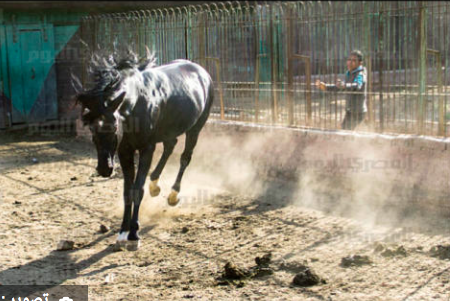
A black horse at the Tanta Zoo, by Alaa al-Kamhawy.
The Alexandria Zoo, empty cages and absent guards
The Alexandria Zoo is the second largest and most beautiful. It has a distinct architectural style that can still be observed, despite many parts of it being destroyed.
However, there are only a few animals left to see. When Karima the elephant died four years ago and the giraffe shortly after, the zoo has not replaced them until today.
Touring the zoo, you will see many empty cages. Ironically, however, you will see signs reading: “Annoying the animals is uncivilized behavior.”
The few remaining animals are neglected. You see the lions sitting exhausted in their smelly cages. But if you tip the guard, he will poke the lion with a stick to roar.
The monkeys are in a grotto below ground level. Instead of throwing bananas to them, the visitors pelt them with stones. A video clip was posted on the Internet, showing two kids who had jumped down and chased and beat the monkeys with sticks.
In April, Suad al-Khouly, the deputy governor of Alexandria, said in a press statement that police forces would be deployed in the zoo to maintain order.
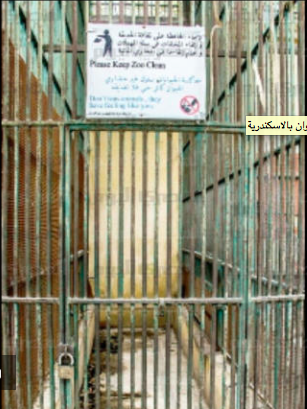
An empty cage at Alexandria Zoo, by Alaa al-Kamhawy.
The Fayoum Zoo, absolute neglect
A small door next to the municipality building takes you inside the Fayoum Zoo, which was opened in 1984. You will see piles of garbage next to the deserted quarters of the elephant, who died 10 years ago.
The hippopotamus lives in a pond with garbage floating on the surface. For the hippopotamus to eat, the animal must pass his head through a narrow slot in the iron fence that surrounds the pond. Often his head gets stuck.
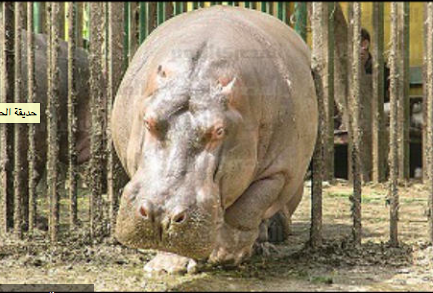
Hippopotamus at the Fayoum Zoo, by Alaa al-Kamhawy.
The Mansoura Zoo, a slaughter house
The Mansoura Zoo was opened in 1949 on an area of three acres in the Turrell neighborhood. The land was donated by an Italian, which is why it is the only park that is not managed by the Central Zoo Management Authority, but rather directly by the Mansoura District Municipality.
Turell had stipulated that the place remain a zoo at all times and not be changed or it should go back to the possession of his heirs. But he never stipulated that the animals needed to be treated well. They are beaten and stoned by the visitors, and there are no guards to protect them.
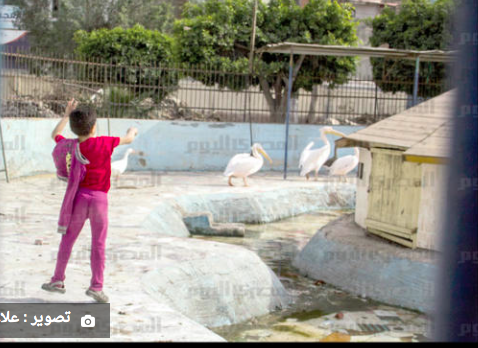
A kid harasses swans at the Mansoura Zoo, by Alaa al-Kamhawy.
The Sharqiya Zoo, only for herbivorous animals
The government had decided that this place be a zoo for vegetarian animals only. The zoo, which was opened in 2000 on an area of 5 acres, does not include carnivorous animals.
Neither the visitors nor the officials of the park are interested in the animals. The swans do not have a pond to swim in. They sit on the asphalt.
The bathrooms are all closed, and the children’s amusement park in it is also closed.
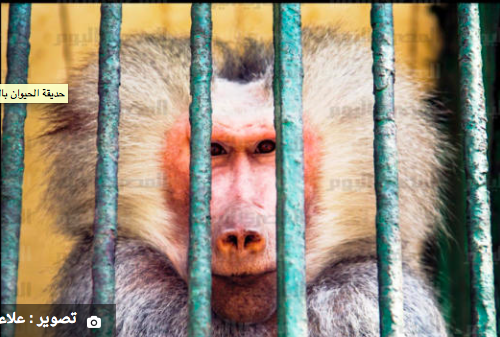
A monkey inside a cage at the Sharqiya Zoo, by Alaa al-Kamhawy.
The Assiut Zoo, rats everywhere
The Assiut Zoo was opened in 1962 to serve the neighboring cities of Sohag and Minya as well. It was named after President Gamal Abdel Nasser. It is the only zoo that overlooks the Nile. The cafeteria has tables and chairs, but no waiters and nothing to sell.
Very few visitors go there because there is nothing but a few monkeys and birds, and a lot of rats.
The local council has allocated LE3 million pounds in February 2015 to develop the place, when the other development plan that was devised in 2013 was not implemented.
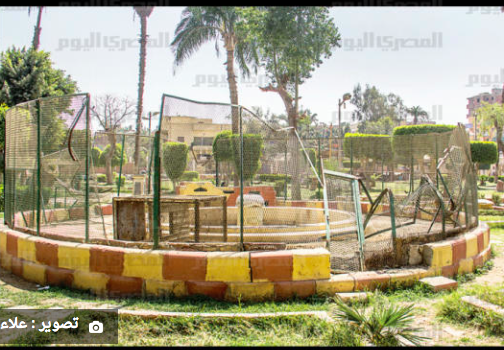
Playground area at the Assuit Zoo by by Alaa al-Kamhawy.
The Beni Suef Zoo, a relatively cleaner place
The Beni Suef Zoo was opened in 1997 on an area of 4 acres. It is relatively clean and unlike the other zoos, free of intoxicating odors, but it has only a few visitors because there aren’t many animals to watch. Children say they want to see elephants, giraffes and bears.
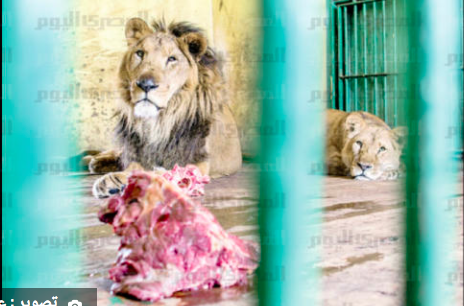
A lion and a lioness inside a cage at the Beni Suef Zoo byAlaa al-Kamhawy.
Edited translation from Al-Masry Al-Youm

